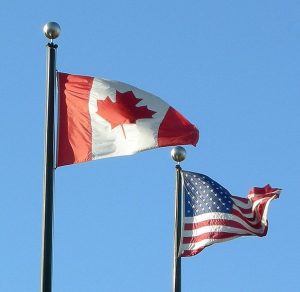Want to go on an exchange to learn English but can’t decide whether to go to the UK, USA or Canada? Contact us to help you or read on for more information.
It is no secret that English is the default international language. This, among other reasons, is due to the fact that certain aspects of its grammar make it easier to learn than other languages, which is why it is often the second language of people born in countries whose mother tongues are other languages. Furthermore, according to an article in Forbes magazine, English is still considered “the language of business” and not Mandarin, despite the great boost to the Chinese economy in recent years.
Now, there are several countries whose official language is English, including the United Kingdom, the United States and Canada, but these questions arise: are there differences between the versions of English spoken in these countries, and if so, which one should be chosen when learning the language?
Differences between American and Canadian English

As to the first question, the answer is that there are indeed such differences. Among these three versions of English, the most similar are the American and Canadian versions, but they do have differences. To name a few, there are words that include the letter “u” in Canadian English, while the letter “u” is suppressed in the U.S. version. Such is the case of the words color, neighbor, flavour, savour and favor, whose equivalents in American English are color, neighbor, flavor, savor and favor, respectively.
Canadian or American:
Also, Canadian English differs from American English in that some words retain the French “-re” ending, as in the case of the words centre and theatre, which in American English are spelled center and theater, respectively.
On the other hand, like the British, Canadians refer to the letter zeta as zed, while Americans distinguish it as zee. Also, Canadians use, among others, the Gallicisms garburator (garbage disposer), serviette (napkin), while Americans refer to them as garbage disposal and napkin, respectively.
Finally, although there are more similarities than differences between Canadian and U.S. English, the more trained ear may notice certain subtleties in the pronunciation of some vowels by which it is possible to distinguish that a person is from a specific area of Canada (and not from the United States), but what definitely gives a Canadian away is the use of the word eh (ah) at the end of each question.
British English
British English, on the other hand, does have important phonetic distinctions with respect to American and Canadian English. Indeed, the British have a tendency to pronounce every word with pristine clarity, except for the letter ere, which they tend to omit.
Differences between British and American English

Differences between American and British
As for the grammatical differences between British and American English, it can be pointed out, among other things, that in the United Kingdom the verb tener is usually expressed with the phrase have got while in the United States it is expressed only with the word have. Likewise, although there are no differences in the conjugation of most English verbs, regardless of their version, there is a difference in the conjugation of the following verbs get and forget (to forget): In British English the past participles of these verbs are got and forgot, while in American English they are used respectively gotten and forgotten.
In addition, the past and past participle of regular verbs are usually formed using the suffix “-ed” at the end of the verb. Such is the case of the verbs push (empujar), pull (halar) and look (mirar) whose past tense and past participle conjugations are pushed, pulled and looked, respectively. This rule applies to both British and American English. However, in British English some regular verbs have their past tense forms created from the “-t” ending instead of using the “-ed”. For example, the verbs dream , burn , and learn in the past tense are written dreamt, burnt, and learnt, respectively. Both variables are fully accepted in British English, only in those specific cases it is more common to use the “-t” ending, while in American English only the “-ed” ending is used.
Where to learn English
In short, each of these versions of English has its own distinctive features, so to answer the second question, it will depend on the student’s tastes and needs: if he or she is a person who wants to be employed by or do business with American companies, he or she would do well to learn the American version of English. The same applies to someone who intends to link up with Canadian or British institutions.
It may also happen that someone prefers British English because they consider it to be more refined or that they prefer Canadian English because of the possibility of learning French in Canada, perhaps at a cheaper price than in the United Kingdom. The important thing in all this is, first of all, to know that the differences mentioned above exist, so that the ducks can be “lined up” in the desired direction, but also to understand that, regardless of the version of English chosen, once the language has been learned, it will be possible to use it with other people who also speak it, despite the differences between the versions.



